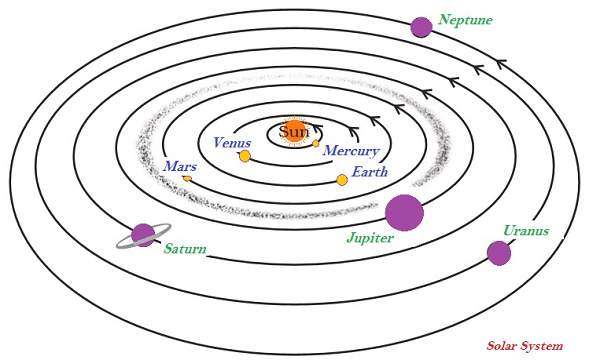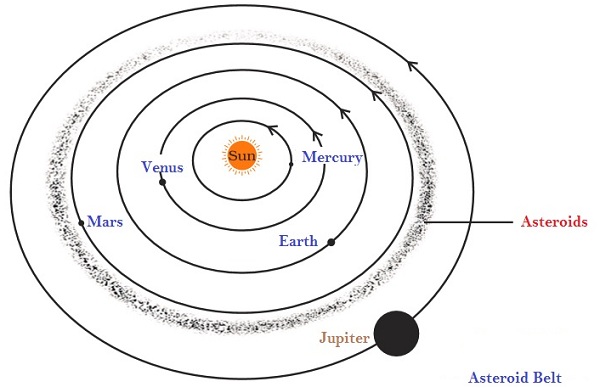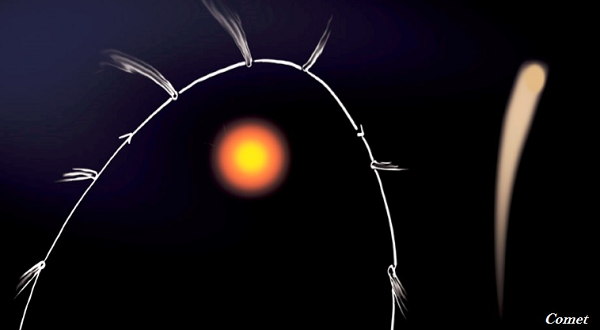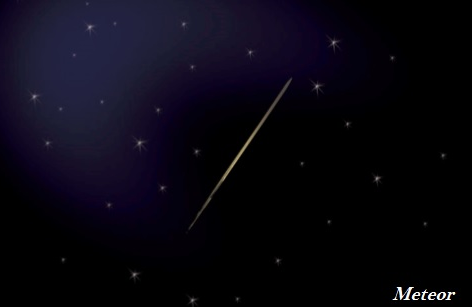
- Physics - Home
- Physics - Force and Pressure
- Physics - Friction
- Physics - Some Natural Phenomena
- Physics - Motion
- Physics - Force and Laws of Motion
- Physics - Gravitation
- Physics - Mass and Weight
- Physics - Work and Energy
- Physics - Light
- Physics - Reflection and Refraction
- Images Formed by Spherical Mirrors
- Physics - Refraction of Light
- Physics - Spherical Lenses
- The Human Eye & Colorful World
- Refraction of Light Through a Prism
- Physics - Electricity
- Chemical Effects of Electric Current
- Magnetic Effects of Electric Current
- Physics - Electric Motor
- Physics - Source of Energy
- Physics - Sound Part I
- Physics - Sound Part II
- Speed of Sound in Different Media
- Physics - The Solar System
- Physics - Stars and The Solar System
Physics - The Solar System
Introduction
The Sun and all the celestial bodies which revolve around it (the sun) are known as the solar system.
The solar system consists of a large number of bodies including planets, comets, asteroids, and meteors.
There are eight planets; they are arranged in their order of distance from the Sun as: Mercury, Venus, Earth, Mars, Jupiter, Saturn, Uranus and Neptune (see the image given below).
The first four planets, Mercury, Venus, Earth and Mars, are known as inner planets.
Jupiter, Saturn, Uranus and Neptune are much farther off from the sun and known as outer planet.

The Sun
The Sun is the nearest star from the earth.
The Sun is about 150,000,000 kilometers (150 million km) away from the Earth.
The Sun is the source of almost all energy available on the Earth.
After sun, Alpha Centauri, is the nearest star from the earth.
Light year is the distance travelled by light in one year.
The speed of light is about 300,000 km per second.
The Planets
There are eight planets that keep changing their positions with respect to the stars.
The planets have definite paths in which they revolve around the Sun.
The path of the planet is known as an orbit (see the image given above).
The time taken by a planet to complete one revolution is known as its period of revolution.
The time period of revolution increases with the distance of the planet increases from the sun.
All planet also rotates on its own axis, which is known as its rotation period.
A celestial body revolving around the planet is known as satellite or moon.
The planet mercury is smallest and nearest to the Sun.
Mercury has no satellite of its own.
Venus is the nearest planet to the earth.
Venus is the brightest planet.
Venus appears in the eastern sky before sunrise and appears in the western sky after sunset; therefore, it is also known as morning or an evening star.
Venus has no moon/satellite.
Venus rotates from east to west.
From space, earth appears blue-green due to reflection of light from water and landmass accordingly.
The Earth has one moon.
Mars appears somewhat reddish and, hence, known as the red planet.
Mars has two natural satellites.
Jupiter is the largest planet of the solar system.
Jupiter is about 318 times heavier than that of the Earth.
Saturn appears yellowish in color.
Saturn has rings around it.
Saturn is the least dense among all the planets (even water is denser than Saturn).
Like Venus, Uranus also rotates from east to west.
The most significant feature of Uranus is that it has highly tilted rotational axis.
There is a large gap between the orbits of Mars and Jupiter; it is filled with some objects known as asteroids and this region is known as asteroid belt (see the image given below).

A Comet appears usually as a bright head with a long tail and the length of the tail grows in size as it approaches towards the sun (see image given below).

Halleys comet appears after (nearly) every 76 years; last seen in 1986.
A meteor is typically a small object that occasionally enters the earths atmosphere.
Meteors are commonly known as shooting stars.

Some meteors are very large and they reach the Earth before they evaporate completely.
The meteor that reaches the Earth is known as meteorite.